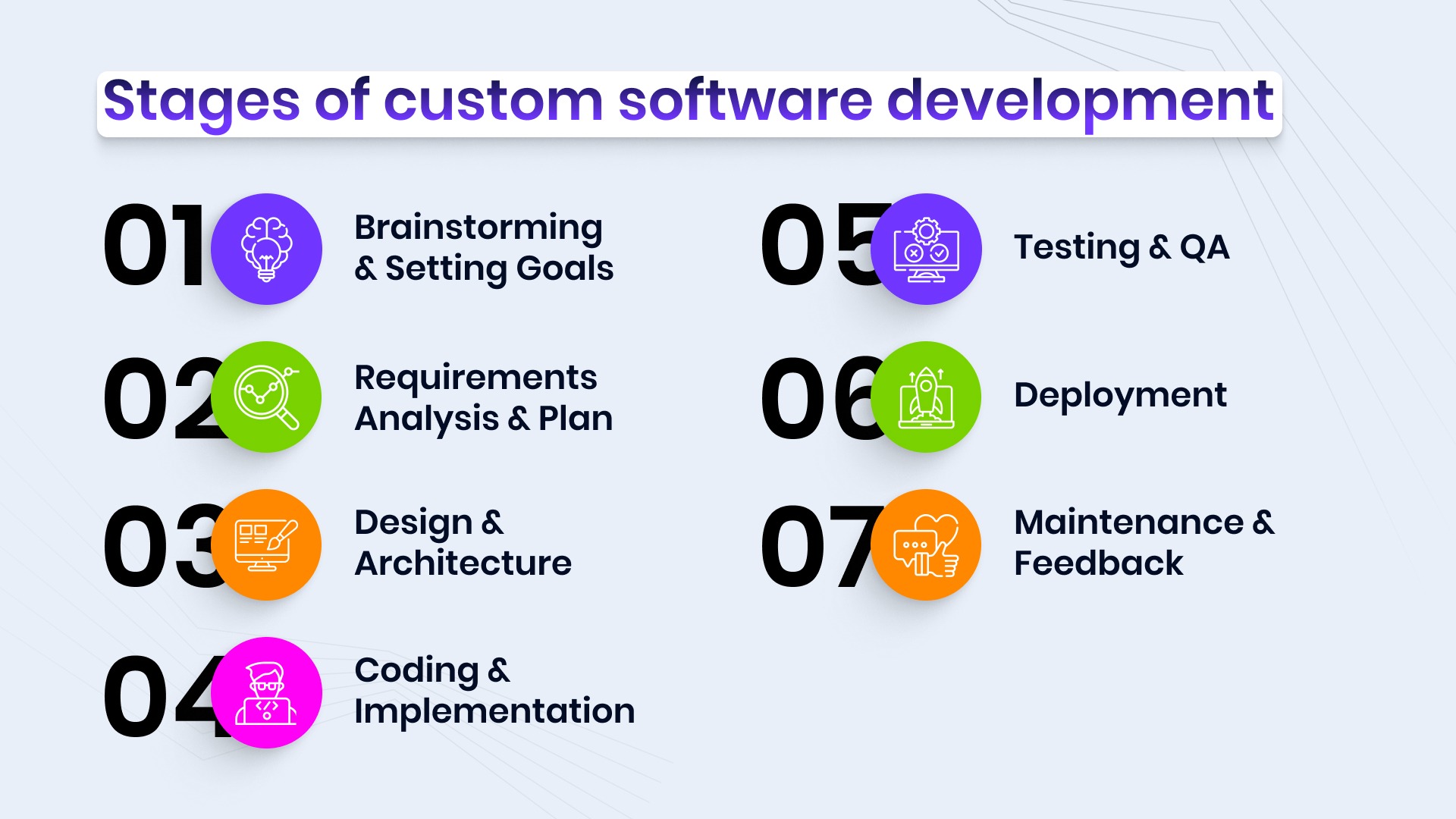
Custom software development is like building a tailor-made suit. Instead of buying something off the rack, you design and create a garment that fits perfectly. This involves understanding the client’s specific needs, creating a design, and then crafting the software to match those requirements precisely.
Stages of custom software development
 1. Requirement gathering
1. Requirement gathering
This is the foundational stage where the software’s purpose is defined. It involves identifying client needs and goals, conducting feasibility studies, and creating detailed functional specifications.
2. Design
The design phase outlines the software’s architecture, user interface, and database structure. Key activities include creating wireframes and prototypes, defining data models and relationships, and designing the software’s overall structure.
3. Development
This stage involves writing the actual code for the software. Activities include building the user interface, developing the backend logic, integrating databases and APIs, and writing unit tests.
4. Testing
Rigorous testing ensures the software functions as intended. This includes unit testing individual components, integration testing to check how components interact, system testing to evaluate the overall system, and user acceptance testing to get client feedback.
5. Deployment
The software is released into the production environment. This involves installing the software on servers, configuring the environment, and deploying the database.
6. Maintenance
Ongoing support and updates are provided. This includes bug fixing, performance optimization, adding new features, and providing technical support.
Options for custom software development
There are several models for developing custom software, each with its own advantages and disadvantages. Here’s a breakdown:
| Model | Pros | Cons |
|---|---|---|
| In-house development | Full control over the project, potential for long-term cost savings, intellectual property protection. | High upfront costs, requires specialized talent, potential for project delays. |
| Outsourcing | Access to specialized skills, cost-effective, focus on core competencies. | Potential communication challenges, reliance on external providers, security risks. |
| Staff augmentation | Combines in-house and outsourced talent, flexibility in team composition. | Requires effective management of both in-house and external teams. |
| Time and material model | Flexible, pay-as-you-go approach, good for projects with undefined scope. | Potential for cost overruns, requires strict project management. |
| Fixed price model | Clear project budget, predictable timeline. | Less flexibility, potential for scope creep, risks associated with underestimation. |
Many organizations combine elements of these models to create a customized approach that best suits their needs. For example, they might build a core team in-house and outsource specific components or augment their team with external experts.
Factors affecting custom software development cost
The cost of custom software development can start from several hundreds to millions of dollars. It is determined by several key factors.
- Project complexity. The number and intricacy of features directly influence development time and cost.
- Team size and expertise. Larger teams with higher skill levels generally equate to higher costs.
- Technology stack. The specific tools and languages used can affect project budget.
- Location. Development costs vary significantly based on geographic location.
- Timeline. Accelerated development often requires additional resources, increasing costs.
- Change requests. Frequent alterations to project requirements can impact budget and timeline.
- Licensing and legal fees. Additional expenses for software licenses and legal compliance.
What is the future of the custom software development?
The future of custom software development is marked by rapid technological advancements and evolving customer expectations. Key trends shaping the industry include AI/ML, low-code/no-code development, cloud-native architecture, cybersecurity, blockchain technology, IoT integration, as well as AR and VR. Overall, custom software development is poised for significant growth as businesses increasingly rely on technology for competitive advantage.
What are the alternatives to custom software development?
While custom software offers tailored solutions, there are other viable options. You can try off-the-shelf software. These are pre-built software packages designed for general use. These solutions offer faster implementation but might not perfectly align with specific business needs.
Software as a Service (SaaS) is another option you can try. These are cloud-based applications accessed through a web browser. They provide scalability and reduced upfront costs but might have limited customization options.
You can also combine custom development with off-the-shelf or SaaS components to create a hybrid solution that balances cost, time, and functionality.
« Back to Glossary Index
